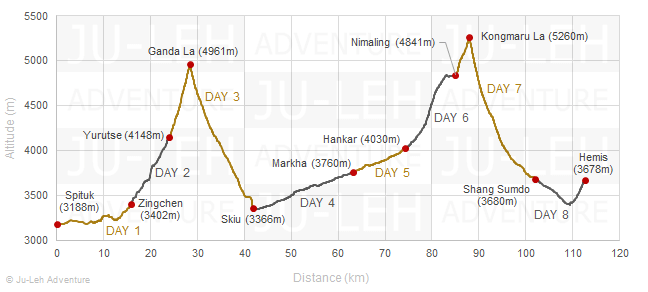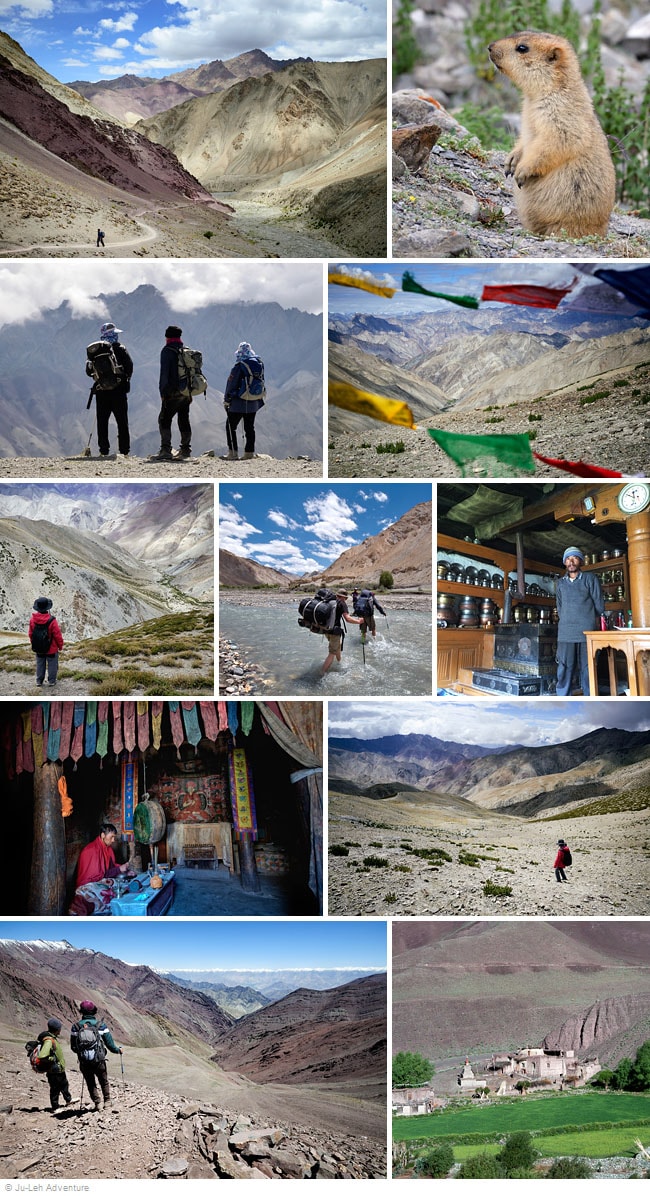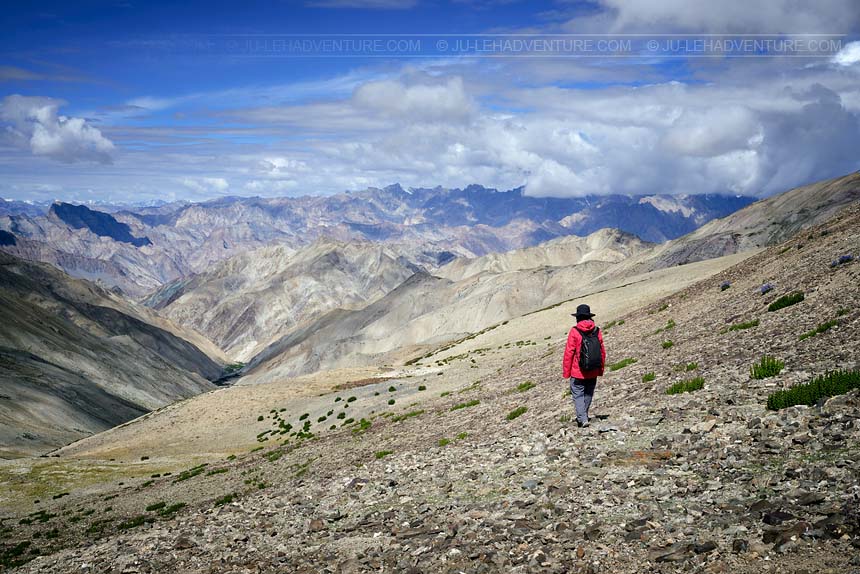Markha valley trek from Spituk
Duration: 8 days
Difficulty: level 3
Distance: 113 km
Max elevation: 5260m
Elevation gain / loss: +4264m / -3774m
The Markha valley trek is one of the most diverse treks in Ladakh. The high altitude passes offer beautiful views of the surrounding snowcapped mountains. There are numerous villages along this remote valley overlooking green oases in the immense arid landscape. Staying in homestay gives an excellent opportunity to discover the everyday life of the villagers and their unique Buddhist culture. The Markha valley is part of the Hemis National Park so there is a high chance of spotting wild animals.
If you would like to join a group, check our Fixed Departure Treks.



Itinerary
Day 1: Spituk - Zingchen
Time: 5 hrs
Distance: 15.7 km
Elevation gain / loss: +375m / -161m
| - | visit Spituk gompa before starting the trek |
| - | follow the south bank of the Indus river until it enters the gorge leading to Zingchen |
| - | possibility to drive from Spituk to Zingchen by jeep |

Day 2: Zingchen - Yurutse
Time: 4-5 hrs
Distance: 8.2 km
Elevation gain / loss: +763m / -17m
| - | the trail continues further through the narrow gorge until it reaches the valley leading to the small village of Yurutse |
| - | homestay possibility in Yurutse |

Day 3: Yurutse - Ganda La - Skiu
Time: 6-8 hrs
Distance: 17.8 km
Elevation gain / loss: +813m / -1595m
| - | a long day to cross the Ganda La and reach Skiu village in the Markha valley. On the way you will see marmots, Himalayan hares, pikas, eagles... |
| - | beautiful panoramic view of the Zanskar and Stok ranges from the pass |
| - | homestay possibility in Skiu |

Day 4: Skiu - Markha
Time: 6-7 hrs
Distance: 21.2 km
Elevation gain / loss: +451m / -57m
| - | it's a pleasant walk through small villages while following the river to reach Markha |
| - | Markha has around 20 families and it is the largest village in the valley |
| - | take your time visiting the gompa and the ruins of an ancient fort above the village |
| - | to enjoy village life, you can stay in homestay |

Day 5: Markha - Hankar
Time: 4-5 hrs
Distance: 11.2 km
Elevation gain / loss: +305m / -35m
| - | follow the trail along the river |
| - | on the way, you can visit Techa gompa, perched on top of a cliff |
| - | homestay can be arranged in Hankar |

Day 6: Hankar - Nimaling
Time: 5-6 hrs
Distance: 10.7 km
Elevation gain / loss: +836m / -25m
| - | follow the trail that leads you to the plateau of Nimaling, where people bring their animals for grazing from June to September |
| - | you can hike to the base of the Kang Yatse glacier in a few hours from Nimaling |

Day 7: Nimaling - Kongmaru La - Shang Sumdo
Time: 6-8 hrs
Distance: 17.0 km
Elevation gain / loss: +439m / -1601m
| - | climb the Kongmaru La, the highest pass of the trek. You will have a great view of the Kang Yatse peaks from the top |
| - | steep and long walk down towards the Shang gorge |
| - | cross the river a few times before you arrive to the village |
| - | homestay is available in Shang Sumdo |

Day 8: Shang Sumdo - Hemis
Time: 3-4 hrs
Distance: 10.7 km
Elevation gain / loss: +281m / -283m
| - | easy walk to reach Hemis monastery, one of the most important gompas in Ladakh |
| - | possibility to drive from Shang Sumdo or Martselang to Hemis by jeep |

Getting to / from the trek
| - | it takes 20 minutes to drive from Leh to Spituk (10 km) |
| - | it takes one hour to drive from Hemis to Leh (40 km) |
It is worth taking some extra time to stop and visit the highlights in the area, check the Indus valley tour to Hemis for more details.
All the itineraries can be customized to suit your own special interests, preferences and abilities. Please contact us for more information.
Markha valley trek - FAQ
How long is the Markha valley trek?
The Markha valley trek is typically completed in 8 days, starting from Spituk and ending in Hemis. This trek covers a distance of 113 km and involves a total elevation gain of 4260m, crossing two high-altitude passes. The 8-day duration includes transportation to and from the starting and ending points of the trek, with the journey beginning and ending in Leh.
How high will I go on the Markha valley trek?
The Kongmaru La pass, at an altitude of 5260m, is the highest point reached during the Markha valley trek. This pass is usually crossed on the 7th day of the trek, when trekkers make their way from Nimaling to Shang Sumdo. The highest overnight stay during the trek is at the Nimaling camp, which is located at an elevation of 4841m, and typically happens on the 6th night, just before crossing the Kongmaru La pass.
How difficult is the Markha valley trek?
The Markha valley trek is classified as moderate in difficulty in comparison to other treks in Ladakh. It is rated as level 3 out of 5. It is important for trekkers to have good physical fitness. A previous trekking experience is desirable, but not necessary as long as you feel confident in your physical condition.
Is the Markha valley trek crowded?
The Markha valley trek is considered the most popular trek in Ladakh due to its natural beauty. Even during the tourist season (July-August), the trek is not really busy, allowing trekkers to enjoy the nature and the mountains without being disturbed by other groups. In comparison to popular treks in Nepal such as Annapurna and Everest Base Camp, the Markha valley trek is significantly less crowded.
How many days of acclimatization are needed before starting the Markha valley trek?
Before starting the Markha valley trek and going higher altitudes, it is recommended to spend a minimum of 3 days acclimatizing in Leh, which is located at an altitude of 3500m above sea level. To aid in acclimatization, it is important to stay hydrated by drinking plenty of water and fluids such as soup, tea, and juice. During this time, you can also explore Leh and the Indus valley.
What will the weather be like during the Markha valley trek?
Ladakh is a high-altitude desert region known for its dry and sunny weather, with daytime temperatures reaching 25-30 degrees Celsius in the summer and cooler temperatures at night depending on the altitude (temperature at Nimaling can be around 5 degrees Celsius in summer). However, it is important to be prepared for sudden changes in weather, including rain, and to be aware that the sun can be strong in the Markha valley trek.
While Ladakh is not affected by the monsoon due to its high mountain ranges, occasional light to moderate showers can occur. All outdoor activities and treks are planned with good weather in mind, but it is important to be fully equipped and prepared for unpredictable weather conditions.
How are the homestays during the Markha valley trek?
The Markha valley trek offers a unique opportunity for travellers to experience the traditional way of living of the local communities in Ladakh by staying in homestays. Every night during the trek, except for the night in Nimaling, will be spent in a local house in a village. This is an initiative to support the rural communities and generate income for them. However, it is important to note that the homestay system does not allow for advanced booking and in some cases, larger groups might be divided into two separate houses.
The comfort in homestays is basic and it does not have running water, but it is a great opportunity to discover the everyday life of the villagers. It is recommended to bring your own sleeping bag during the trek, and if you feel cold, blankets are available in homestays and at Nimaling camp, although they might be dusty. At Nimaling, tents and mattresses will be provided.
What kind of food can I expect during the Markha Valley trek?
During the trek, you will be provided with traditional vegetarian Ladakhi meals such as rice, dal (lentils), vegetables, soup, momos, chutagi, and thukpa. The homestay family will also prepare a packed lunch for you each morning, which may include items such as chapati, potatoes, and boiled eggs. Keep in mind that the food options are simple and may not offer a lot of variety, as it is what the villagers typically eat on a daily basis.
Where can I find drinking water during the Markha valley trek?
Boiled or filtered water will be available to fill up your water bottles during the trek. It is also recommended to bring water purification tablets for added safety.
Is it possible to charge my phone or camera during the Markha valley trek?
Many homestays have solar panels, which allows for the charging of batteries during the trek. It is recommended to bring spare batteries as well, as they may discharge faster in cold weather.
Will my mobile phone work during the Markha valley trek?
Only phones with a local SIM card will have service in Ladakh. Network coverage may be limited in the Markha Valley. Each village has a satellite phone that can be used in case of emergency, but personal satellite phones are not allowed in Ladakh.
What should I pack for the Markha Valley trek?
For the trek, you should keep a light backpack with you during the day with essentials such as a water bottle, packed lunch, hat, sunglasses, sun cream, camera...
Will I have a porter during the Markha valley trek?
In Ladakh, horses are typically used to transport luggage during treks, rather than the use of porters.
During the Markha valley trek, horses will carry your duffel bag or backpack that contains your sleeping bag and any clothes you won't need during the day. It is important to note that the bag should be of reasonable weight and size, and hard suitcases are not suitable as they cannot be transported by horses. Any additional luggage that is not needed during the trek can be stored at your hotel or guesthouse in Leh.
What is the group size for the Markha valley trek?
If you join a group trek for the Markha valley, there will be between 4 and 9 participants. If you book a private trek, you can decide about the group size as well as the trekking dates.
How do I get from Leh to the Markha valley trek?
Transportation from Leh to Spituk, the starting point of the trek, and from Hemis to Leh, the end of the trek, will be arranged by car. The distance between Leh and Spituk is 10 km and between Hemis and Leh is 40 km.


 Hemis to Tso Moriri
Hemis to Tso Moriri




